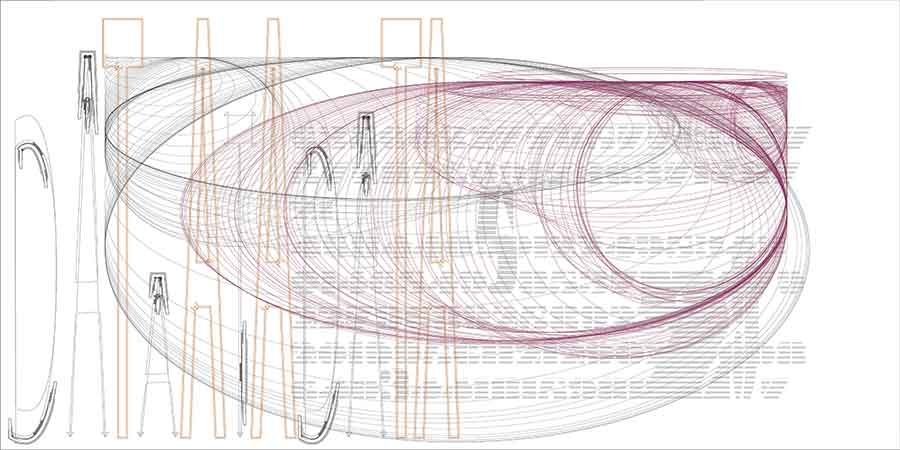Words by Charlotte Kent

On May 17th at 9 pm in New York City, as the virus waned but continues to haunt our lives, I wore a mask and joined artists Chris Klapper and Patrick Gallagher on their rooftop. They were projecting the work of fifteen different artists, their own included, based in Rome and New York City for Lazzaro Art Doesn’t Sleep, an exhibition projected on the buildings in the silence of this long lockdown, according to Laura Mega, an artist and co-organiser. The project was born from a collaboration between Claudia Pecoraro, curator and researcher based in Rome, and the visual artist Laura Mega, who is based in New York but found herself in Rome for the quarantine.
The contemporary art scene is global, but Rome and New York City have a particular place in the heart of art history. If the story as it was once told started with Greco-Roman statuary, it landed in New York City two thousand years later before dispersing so that there is no centre anymore, online or off. And yet, COVID-19 made Italy and New York centers once more of a global pandemic. That, too, seems now to disperse, but as it does we are left wondering what will come of art, its worlds and markets. Has the shift to digital viewing rooms and online studio visits changed our relationship to art? Will people return to galleries and museums? Will they engage in interactive works? Stand, sit, or listen through performance projects? Welcome the intimacy of sensation or fear it?
Art challenges. Individual works have caused outrage throughout time, but so have exhibition choices. Sometimes those come from a refusal of the entrenched power brokers—academies, salons, or galleries. Currently, we see how galleries are innovating in response to a global shutdown. In that context, Lazzaro Art Doesn’t Sleep maintains the importance of community. As Klapper said later in an interview, the gathering on her rooftop was her “first experience seeing people…artists can be very insular but also very social and these times offered no outlet to be with artists, bounce around ideas, get thinking in a different way.” The conversations with others at gallery openings, after seeing an exhibit, or in remembrance of difficult, favourite, or troubling works are a part of how art thrives.
Mega and Pecoraro wanted to bring art back: Anyone with a projector – people, associations, public or private institutions – to place their projectors out of their windows and project onto the walls of the buildings in front of them. We want to invade inhabited streets, squares, courtyards, gardens, monuments… all public spaces that have been forced into silence during this period.
Klapper and Gallagher were the 2020 Artist Residents at Fermilab and made visible the largely silent work of science. Though unable to be on-site, they were developing new works based on their time at the particle physics and accelerator laboratory, which describes its work with surprisingly poetic language:
What are we made of?
How did the universe begin?
What secrets do the smallest, most elemental particles of matter hold,
and how can they help us understand the intricacies of space and time?
As a part of the residency, Klapper and Gallagher continue their interest in the beauty and power of raw information, where data is a compositional element, as in their Dataatadata series. Though they don’t reference the Algorists in discussing their approach, they have a similar interest in showing how programming is a tool that serves the vision and passion of the artist who creates the procedure, as Roman Verotsko explains on his site. The standard model of particle physics doesn’t explain everything, but it made possible the computers and digital communication systems for Lazzaro, and much of the rest of our mundane lives.
Klapper and Gallagher see themselves as translators for the mysterious process of these particles that we can never see but whose presence we recognize from their pathways. A neutrino is known as a ghost particle for this reason, and that invisible presence was apt for the Lazzaro project as Pecoraro saw it: LAZZARO has stitched concrete and invisible relationships in urban networks and the ether. It would not have existed without social media, because the explosion of live videos and images published from every neighbourhood and from every city made us feel part of a whole and yet the works are ephemeral, projections of light, present on temporarily.
Every projector varied the works’ presentation––at different scales, brightness, and proportions, vertically, and horizontally. Art is rarely so flexible. Klapper and Gallagher described the excitement of the show and the warped images, to see how different they looked in different places…another perspective on the work as if through someone else’s eyes. Scientists seeing artists’ visualizations of their work often say something similar.
The content, as well as the display choice of exhibits like Lazzaro, ask us to think about art differently and how it will continue to thrive in a world that is shifting in ways we can barely discern now. Like the movement of neutrinos, we will only see what we have done, the paths we have picked later. The desire, even the need, to shift out of lockdown is clear. What we have to examine is the way our current digital tools along with our imagination make new options possible, allow us to see ourselves, our projects, even our politics in a different light.





